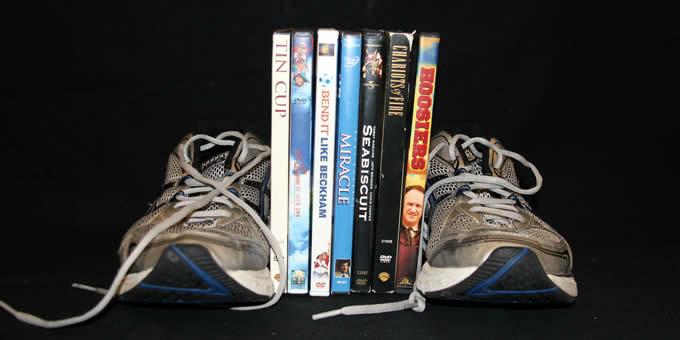Interim: Sports in Film and Fiction

Looking for a conversation starter? Ask anyone for a list of their favorite sports films or books. That same conversation is the driving force behind a Calvin winter interim course titled: “Sport, Film and Fiction,” co-taught by professors Brian Bolt and Jim Timmer of the Calvin HPERDS department.
Over the duration of the three-and-a-half week course, students view and review 12 sports-related films while also reading and reviewing one sports-themed book. Bolt and Timmer first offered the interim course two years ago and are back for another go-around with 36 students enrolled for this year's offering.
The class originated with Bolt, who first taught a version of the sports film class as a professor at Roanoke College. With Timmer’s help, the Calvin version of the course has evolved into a class modeled after the NCAA basketball tournament.
Regions of film critics
The class is separated into three groups called “regions.” Each regional group must view eight films and read one book over the the duration of the course. Timmer and Bolt assign four of the eight films to each of the groups, which are dubbed: “automatic bids.” The final four films for each regional group are considered “at-large” films and are selected off a pre-approved list in a “draft,” with each regional group receiving four selections.
Each group watches one film per day together, and each individual in the group must then submit an online review of the film that same day.
When the students have screened everything, the films enter a bracket competition with movies going head-to-head round by round. Two finalists emerge from each of the three regions and are voted on by the entire class to decide an overall winner.
Guiding discussion principles for the debates include: sport authenticity of the film, the quality of the film, what the film has to say about life, signature lines or quotes from the film. and the hook or emotional pull of the film.
“I used the bracket idea when I was teaching in Virginia (Roanoke College) and it really helped spur healthy discussion and engagement,” said Bolt. “When I taught the class for the first time last year with Jim, he really added a creative flavor with the draft concept and other sports labels that enriched the course. As a result, our students really become engaged with sports, film and literature through a Christian perspective."
Tough matchups
On the final day of class, the final films are ranked one through six in a format similar to the current college football Bowl Championship Series. What follows is a lively debate. Difficult matchups ensue. This year, for instance, one region had to decide between a pair of Angelo Pizzo-directed films, Hoosiers and Rudy, in a first round matchup. “It really is a lot like the NCAA (basketball) Tournament,” laughed Timmer. “Sometimes you get tough first round match-ups, but that really forces the students to think hard right away.”
Hoosiers was one of the films pre-selected by Timmer and Bolt. Some of the professors’ other pre-selects include Million Dollar Baby, A League of Their Own, The Blindside and recent documentaries from the acclaimed ESPN Films’ 30 For 30 series.
One of the films viewed in each group is based on the required reading. This year’s books included Seabiscut, Bang the Drum Slowly and Friday Night Lights.
“Last year when we taught the class, we selected three fiction books for the class to read that were not connected to any films,” said Timmer. “There ended up being a little bit of a disconnect with our students because of that. As a result, we decided to try something different this year by assigning highly acclaimed books, such as Laura Hillenbrand's Seabiscuit, that were made into major motion pictures, and so far it has really worked out well. The book-film combination allows students to evaluate a sports story on two fronts, both in written and visual form. We've been looking at how Hollywood takes a message from a book and adapts the message for its own purposes—particularly in the way of turning a profit. It's definitely created some interesting discussions in class.”
The four pre-selected films are chosen to highlight certain themes, narrative choices and ideas said Timmer. “I guess you could call it a group of sports film fundamentals that we want each region to digest. The at-large choices allow each region to add a little flavor to their movie base. Maybe it's something with a bit more comedy or maybe it's something with a little more history or drama. The students have fun choosing the at-large selections and deciding what kind of a final list they will work with.”
As for a consensus on the top sports film, Bolt claims it varies from year-to-year. “I've taught this course three times before and each time a different winner has been picked as the top sports film,” he said. “Different generations see films differently. The thing that seems to attract the current generation in a sports film is a 'feel-good' story, particularly in more recent films.”
The students also discover that watching sports films takes work but is also rewarding. “We want our students to be more than just consumers, and that includes watching a movie or reading a book,” said Bolt. "We know that our students will see more sports movies and read sports stories after they graduate from Calvin. This course is designed to help them develop skills that will serve them well in the future.”






